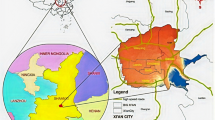Abstract
The challenges of rapid urbanisation are multi-faceted. During the past few decades, many different concepts about the urban sustainability under the threats of climate change (CC) have been studied. Resilience is among the most recent concepts, used for the first time in the 2000s and has ever since attracted greater attention and interests from both academia and urban authorities, and has subsequently applied in urban planning. In order to develop and manage cities to be resilient, many studies show that the Remote Sensing (RS) and Geographical Information System (GIS) could be useful to architects, urban planners and municipalities in the urban planning process. This study selected the case of capital city Phan Rang-Thap Cham, the most urbanized area of Ninh Thuan province, in the center of Vietnam; it has been known as one of the coastal cities that are affected by CC, drought, storms, floods and sea level rise. Among those phenomena, drought—the most serious hazard was picked up for exploration recently. We utilized RS and GIS to examine city’s Land Use and Land Cover (LULC), then extract the most relevant drought-induced factors in the years of 1991, 1997 and 2019, such as: Land Surface Temperature (LST), Normalised Difference Vegetation Index (NDVI), and Normalised Difference Built-up Index (NDBI). The study results show inter-relationships and transformations of the three indicators in Ninh Thuan context, where urban land temperature and Urban Heat Island (UHI) are raised by built-up areas and in contrast, reduced by vegetated areas. As a result, urban green spaces would be a driver to mitigate urban heat and moving toward drought resilience.
Access this chapter
Tax calculation will be finalised at checkout
Purchases are for personal use only
Similar content being viewed by others
References
IPCC (2014) Climate change, adaptation, and vulnerability. Organ Environ 1–44
Dai A (2011) Drought under global warming: a review, pp 55–57
Pickett STA, Cadenasso ML, McGrath BM (2013) Ecology of the city as a Bridge to urban design. In: Resilience in ecology and urban design, pp 7–28
Jhawar M, Tyagi N, Dasgupta V (2012) Urban planning using remote sensing, pp 42–57
Eraydin A, Taşan-kok T, Stead D, Taşan T, Lu P, Dias LF, … Henriksson A (2013) Resilience thinking in urban planning, pp 39–51
Holling CS (1973) Resilience and stability of ecological systems. Annu Rev Ecol Syst 4:1–23
Folke C (2006) Resilience: the emergence of a perspective for social-ecological systems analyses, pp 253–267
Holling CS, Gunderson LH (2002) Resilience and adaptive cycles. Understanding Transformations in Human and Natural Systems, Panarchy, pp 25–62
Millennium Ecosystem Assessment (2005) Millennium Ecosystem Assessment: ecosystems and human well-being
Sendai Framework for Disaster Risk Reduction (2015) Sendai framework for disaster risk reduction 2015–2030, pp 1–25
Meerow S, Newell JP, Stults M (2016) Defining urban resilience: a review. Landscape Urban Plann 147:38–49
Davoudi S, Strange I (2009) Space and place in the twentieth century planning: an analytical framework and an historical review, pp 7–42
Fleischhauer M (2008) The role of spatial planning in strengthening urban resilience, pp 273–298
Hoa NT, Vinh NQ (2018) The notions of resilience in spatial planning for drought—flood coexistence (DFC) at regional scale, pp 14–16
Ni’mah NM, Lenonb S (2017) Urban greenspace for resilient city in the future: case study of Yogyakarta City, vol 70, pp 0–8
Dissanayake D, Morimoto T, Ranagalage M, Murayama Y (2019) Land-use/land-cover changes and their impact on surface urban heat islands: case study of Kandy City, Sri Lanka, p 99
Crossman ND (2018) Drought resilience, adaptation and management policy (DRAMP) framework, p 17
Singh VK (2017) The applicability of night time remote sensing data in Indian context to analyze urban dynamics, pp 29–30
Feng X, Fu B, Yang X, Lü Y (2010) Remote sensing of ecosystem services: an opportunity for spatially explicit assessment, p 2
Lachowski HM, Johnson VC (2001) Remote sensing applied to ecosystem management, pp 135–136
Rouse W, Haas RH, Deering DW (1974) Monitoring vegetation systems in the Great Plains with ERTS, NASA SP-351. In: Third ERTS-1 symposium, vol 1
Acknowledgements
The authors wish to acknowledge the assistance and encouragement from the colleagues at the Department of Architecture, Department of Geomatics Engineering, Faculty of Civil Engineering, HCMC University of Technology, VNU-HCM, Ho Chi Minh City, and from HCMC University of Transport, as well as the support from the Construction Department of Ninh Thuan province.
Author information
Authors and Affiliations
Corresponding author
Editor information
Editors and Affiliations
Rights and permissions
Copyright information
© 2020 Springer Nature Singapore Pte Ltd.
About this paper
Cite this paper
Vinh, N.Q., Khanh, N.T., Anh, P.T. (2020). The Inter-relationships Between LST, NDVI, NDBI in Remote Sensing to Achieve Drought Resilience in Ninh Thuan, Vietnam. In: Reddy, J., Wang, C., Luong, V., Le, A. (eds) ICSCEA 2019. Lecture Notes in Civil Engineering, vol 80. Springer, Singapore. https://doi.org/10.1007/978-981-15-5144-4_15
Download citation
DOI: https://doi.org/10.1007/978-981-15-5144-4_15
Published:
Publisher Name: Springer, Singapore
Print ISBN: 978-981-15-5143-7
Online ISBN: 978-981-15-5144-4
eBook Packages: EngineeringEngineering (R0)




